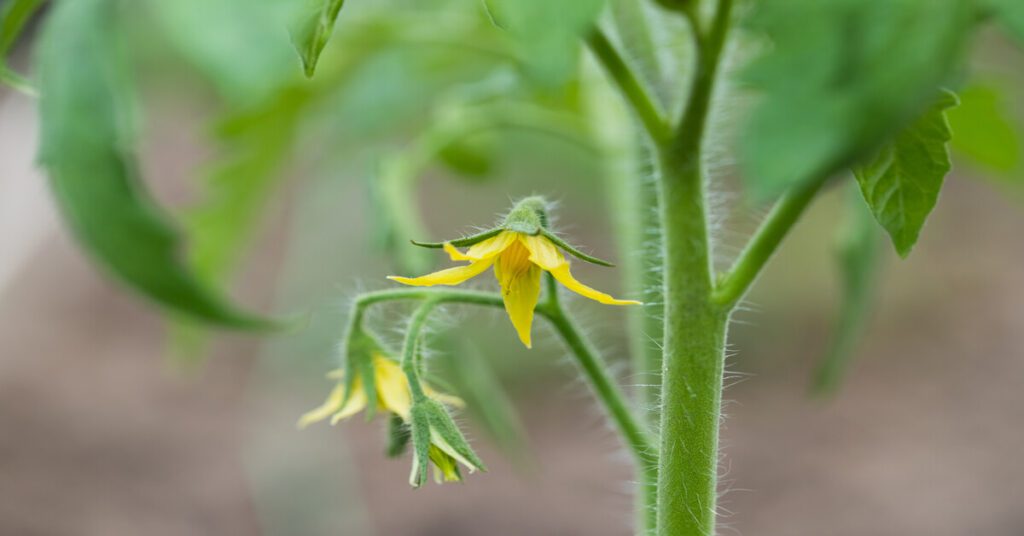Occasionally, your tomato plants may suddenly lose their flowers mid-bloom, ceasing to produce any fruits. This frustrating condition is called tomato blossom drop and occurs when tomatoes encounter nutritional or environmental stresses, or a combination of the two.
Tomatoes are self-pollinating plants and will usually pollinate themselves in the wild. Typically, gentle rustling from the wind or movement of bees will help your tomatoes pollinate.
However, when environmental and nutritional stresses occur, your plants may abort the pollination process and lose their blossoms.
Besides tomatoes, blossom drop can also affect peppers, snap beans, eggplant, and other warm-season fruiting vegetables.
What is Tomato Blossom Drop?
Simply put, blossom drop is the loss of flowers. Although it can occur suddenly, blossom drop is typically preceded by the yellowing of the pedicels (the small stems which hold flowers).
Besides yellowing pedicles, the flowers on affected plants will look shriveled and shrunken. A gentle flip or tap with your fingers will cause the flowers to fall or drop off.
This occurs because your plant is under stress, which causes it to redirect its energy away from flowering and fruiting and toward basic survival.
Causes of Tomato Blossom Drop
Blossom drop is primarily caused by environmental and nutritional stress, with the primary factors outlined below:
- Extreme temperature is the primary cause of blossom drop. Ideal temperatures are 70-75°F (21-24°C) in the daytime and 60-65°F (16-18°C) at night.
If nightime temperatures consistently fall below 55°F (13°C) or rise above 70°F (21°C), or if daytime temperatures consistently rise above 85°F (29°C), your tomatoes will abort pollination.
In extreme temperatures above 104°F (40°C), even just four hours of exposure is enough for your plants to stop pollinating and lose their flowers.
Low temperatures affect the growth of pollen tubes, causing them to become sterile, which prevents normal fertilization and causes blossom drop.
Fruits do not set unless nighttime temperatures are above 55°F (13°C) for two consecutive nights.
High temperatures, especially at night, causes food produced during the day to rapidly deplete. High temperatures and rapid food depletion causes female flowers to dry out and pollen to become sticky and non-viable – leading to aborted pollination.
- Too high or too low relative humidities negatively impact pollen transfer. Low humidity dries out pollen and makes them unable to stick to the female stigmas. Extremely high humidity also prevents pollen from properly shedding.
The optimum relative humidity for tomatoes is between 50-70%. Deviating too far outside this range will negatively affect pollination, causing blossoms to drop.
- Nitrogen, either too much or too little, applied during fertilization may also contribute to blossom rot. Too much nitrogen causes plants to grow excessive foliage at the expense of fruit setting. Too little nitrogen causes vines to become spindly and unable to support fruit. [1]
The secondary factors below also increase the likelihood of blossom drop:
- Low or high soil moisture damages roots, which may weaken and stress your plants.
- Too many blossoms will also create competition for resources. Plants that produce too many flowers will sometimes abort a few to conserve resources.
- Excessive pruning and wind. Too much wind causes flowers to dry out, and too much pruning may affect the plant’s energy production. Both may reduce flower production.
- Lack of light or extended exposure to light also impacts pollination. Plants with too little light will redirect energy away from reproductive parts to parts that better capture light like stems and leaves. Too much light, especially artificial light, may impact processes that trigger pollination at night.
- Insect damage or diseases such as botrytis and bacterial spot will also negatively affect the plant’s ability to pollinate and bear fruit.
How to Prevent Tomato Blossom Drop
To prevent blossom drop, there are a number of things you can do:
- Grow heat resistant varieties. Cherry tomatoes, for example, are particularly resistant to heat and humidity and are often grown in more tropical climates.
Other heat tolerant varieties include: Arkansas Traveler, Bif Beef, Black Krim, Busy Early Girl, Cherokee Purple, Isis Candy, Super Sioux, Super Sweet 100, Sweet Million, and Virginia Sweets, Pink Brandywine, Sunchaser, Sunripe, among others.
- Apply an appropriate amount of nitrogen. Use a fertilizer with about half as much nitrogen as phosphates and potassium (NPK ratio: 5-10-5 or 5-10-10).
- Avoid moisture stress by watering deeply during high heat. Tomatoes have roots that can go as far down as 5 feet (1.5 m) below ground.
- Spray some water directly on your blossoms twice during the day and at night. This raises relative humidity and helps loosen pollen. Avoid spraying if temperatures and humidities are already too high.
- Give your plants appropriate light for the climate. Avoid artificial light at night, which can interrupt pollination.
- Control insects and diseases to limit the amount of stress to plants.
- Spray with commercially-available tomato hormones, which may help regulate pollination and fruiting. Apply directly to the flowers themselves, as spraying the entire plant can damage them. Apply during flowering and again 15 days later.
References:
[1] Ozores-Hampton, M., Kiran, F., & McAvoy, G. (2012). Blossom Drop, Reduced Fruit Set, and Post-Pollination Disorders in Tomato. EDIS, 2012(7). https://doi.org/10.32473/edis-hs1195-2012

